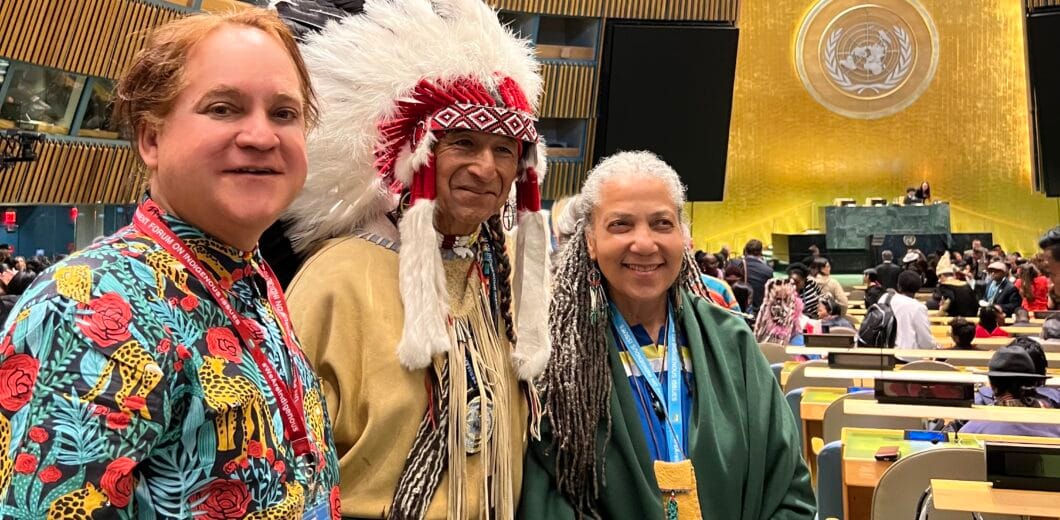Todd Theringer, North America NGO Delegate, reflects on his recent participation at the United Nations Permanent Forum on Indigenous Issues held last 21 April – 2 May
After recovering from two weeks of full-day plenary sessions and side events at the United Nations Permanent Forum on Indigenous Issues (UNPFII) hosted in different locations across New York City and often scheduled for the same time, I remain committed to the need for UNAIDS and their co-sponsoring UN agencies, country governments, the private sector, community leaders and all stakeholders to continue to work diligently toward achieving the UN’s Sustainable Development Goal (SDG) 3.3 where one of the critical targets is the elimination of HIV as a public health threat by 2030.
I admire the determination of so many under-resourced Indigenous groups who journey to the UN to tell their truths to the world. I just hope that someone will read all of those carefully worded 3-minute interventions and follow up on bringing justice to these admirable advocates. But what I witnessed is that HIV didn’t seem to be a priority for anyone but for those in our small group and yet Indigenous Peoples can be found in every key population. I learned the most from the side events where presenters shared their knowledge, experience, and fears in doing the most with less in their communities. HIV continues to rise within Indigenous populations without any targeted programming to stop this disturbing trend.
How could HIV and healthcare get lost in the ranking of priorities for Indigenous peoples? I also grew frustrated at the disorganization of the whole process. People spent their whole day waiting to read their statements only to not be called on once it turned 6 p.m. No one could figure out how the chairperson of that day determined which group to call next. Those who sat with anticipation of being called missed out on attending any of the side events which were the only opportunity to network with others.
The National Native American AIDS Prevention Center (NNAAPC) in the US partnered with CAAN Communities Alliances and Networks from Canada and the Latin American and Caribbean Coalition of Indigenous Peoples in Response to HIV AIDS in delivering joint interventions at the 24th UNPFII in New York City. One intervention focused on Item 5(g): Thematic dialogue on the financing of Indigenous Peoples’ work and participation across the multilateral and regional system. Sustainable Development Goal Target 3.3 calls for an end to the epidemics of AIDS, tuberculosis, malaria, and neglected tropical diseases, and to combat hepatitis, waterborne diseases, and other communicable conditions. Indigenous communities continue to face disproportionate burdens from these diseases—challenges compounded by systemic inequities, entrenched access barriers to quality healthcare, and enduring colonial legacies. A second intervention focused on Item 5 (e): Interregional, intergenerational, and global dialogue. Our statement addressed the pervasive crisis of gender-based violence as it affects Indigenous communities worldwide—a crisis that undermines the rights, safety, and dignity of Indigenous women, girls, two-spirit, and gender-diverse individuals.
HIV stigma is alive and funding cuts to HIV services and shrinking spaces for civil society only serve to silence the response to HIV. HIV stigma has found a natural ally in the fear of loss of funding for any program that dares mention HIV. The UNAIDS goal of End AIDS 2030 will never be reached if we are reduced to whispering HIV. Funding cuts to HIV civil society organizations means HIV advocacy will be further silenced and there won’t be anyone to speak up for those Indigenous people and communities who have been historically left behind.
The UNPFII did not promote HIV as a serious topic even after UNAIDS issued a press release. I contacted every single person who serves on the board of the UNPFII asking them to post the UNAIDS press release on the need for continued attention to fighting HIV in Indigenous communities and received no response. Who decides at UNPFII what topics are worth mentioning and which will be ignored? There is no limit on how many social media posts can be done in a day.
For two weeks, Indigenous peoples sat in solidarity listening to each other’s stories and calls for justice patiently hoping for change and action from their governments and the world. We all journey to the UNPFII because we believe we can make the world a better place and with 476 million indigenous peoples in the world, the UN is the only place where we have a chance to be seen as not being too small in population to matter. The UN might consider having regional Indigenous conferences which would give more organizations a chance to participate in influencing policy and social change instead of one overwhelming conference that isn’t able to adequately deal with the demand for its attention. Ending human suffering from HIV should be a goal that unites us all to fight to reach the goals of END AIDS 2030. We are capable of advocating for more than one subject at a time. There is no contradiction for a disability advocate to mention HIV because a disabled person can be living with HIV. We have to stop thinking in silos and focus on what we can do to end human suffering and once that becomes our motivating force we can truly connect as one world and stop saying it is something out of our control and leaving it up to someone else to solve.

